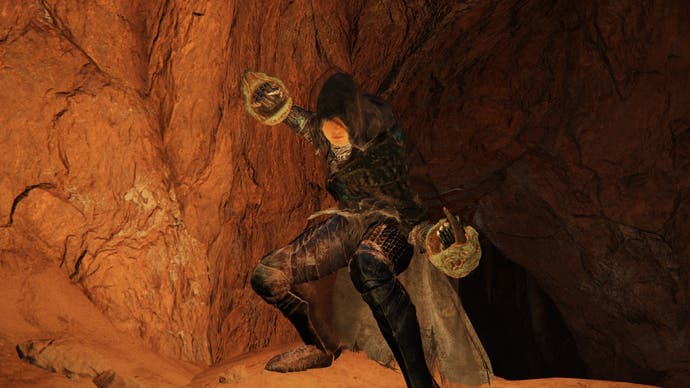Best claws in Elden Ring
Channel your inner Wolverine with these deadly hand-blades.
Choosing the best claws in Elden Ring is perhaps an easier task than with other weapon types. After all, there are only four claw weapons in total in The Lands Between, meaning it’s a bit more straightforward to work out which claws might suit your character build.
In our option, there are still enough differences between each of ’s claw weapons to make them worthy of careful consideration. While all claw weapons rely on Strength and Dexterity as their core required stats, each one has its own unique way of cutting enemies down to size.
For this list, we've focused on claws that can inflict additional status effects, as for us, this puts them a cut above those focused on purely physical damage. So read on below for our top picks for the best claws in Elden Ring, which also detail the minimum stat requirements for each bit of gear, their different combat abilities and how best to use them.
Best claw weapons in Elden Ring
Take the blistering speed and raw strength of Elden Ring’s fist weapons and combine them with the nimble slashing and bloodletting ability of daggers, and you end up with claws. These Wolverine-like weapons might sacrifice the longer reach of full-sized swords, but they allow for a relentless flurry of slashes that can quickly inflict high damage along with massive Bleed build-up and increased critical strike damage. They excel in inflicting status effects, too, especially when enchanted with spells such as Bloodflame Blade for additional Bleed and fire damage.
As they're nimbler than Strength-based fists, claws typically rely on Dexterity as their main stat when it comes to scaling, though you’ll need at least a bit of Strength to wield them at all. That mobility means that claws are often exceptionally light compared to many other weapons, saving equip load for heavier armour or increased stamina and evasion.
Raptor Talons

The Raptor Talons are found a little later in Elden Ring’s main quest, inside a hidden chest behind a set of secret walls in the Sage’s Cave dungeon on the way to Mt. Gelmir. They require 6 Strength and 14 Dexterity to use, once again scaling best with Dexterity.
The Raptor Talons are unique among the claws in Elden Ring thanks to their distinct heavy attack, which executes a very fast leaping attack when charged. The Raptor Talons in general favour attacks made in the air, delivering quicker blows than other claws. They also have a higher-than-average critical strike value, meaning they will cause increased damage when used to backstab enemies or attack vulnerable or staggered foes after parries.
As with other claws, the Raptor Talons inflict both physical damage and rapid Bleed, and come with the evasive Quickstep as their default skill - although you can switch that to another Ash of War if you prefer.
Venomous Fang

Whereas most claws focus on building up enemies’ Blood Loss, the Venomous Fang - as you might guess from its name - instead offers a poisonous alternative. Requiring stats of just 9 Strength and 9 Dexterity to wield, this toxic claw comes equipped with the power to inflict deadly poison on your enemies with every strike.
The Venomous Fang can be found in Caelid’s Abandoned Cave dungeon, which is suitably inhabited by poison-causing enemies and filled with pools of deadly scarlet rot. The weapon is hidden behind a Giant Poison Flower.
Although the Venomous Fang lacks the flexibility of the other claws in Elden Ring - with a lower critical stat to boot - it is the go-to claw for those looking to poison their enemies quickly. Upgrading the fang to add an additional poison upgrade hugely increases the amount of poison it causes by stacking the extra elemental effect on top of its original poison status, massively multiplying its build-up and damage caused. Alternatively, you can consider combining the poison effect with another element or status such as Blood Loss and Frostbite.
Bloodhound Claws

Unlike our other top picks for the best claws in Elden Ring, the Bloodhound Claws are, in fact, focused on mostly dealing purely physical damage rather than inflicting additional status effects. The main reason why we've still included it on this list, though, is because of its unique skill. Instead of the usual Quickstep skill, the Bloodhound Claws come with the Bloodhound Knight variant, Bloodhound’s Step. The evasive move turns the players invisible as they effectively teleport a short distance forward, making it even faster and better at dodging than the standard version.
They also have higher stat requirements than other claws, coming in at 10 Strength and 15 Dexterity. Those increased requirements grant you the weapon’s unique passive effect to ignore some of the damage negated when opponents block, making these claws formidable when applying the pressure to enemies and forcing them to put up their guard. Combine that with their ability to inflict high Blood Loss, and they're made all the more deadly thanks to their ability to break through enemies’ guards.
To obtain your own Bloodhound Claws, you'll need to defeat the Bloodhound Knight in the hidden basement of Volcano Manor.
Need more help? Jump back to our list of best Elden Ring builds or our Elden Ring walkthrough.





.png?width=291&height=164&fit=crop&quality=80&format=jpg&auto=webp)

_MEGHzTK.png?width=291&height=164&fit=crop&quality=80&format=jpg&auto=webp)
.png?width=291&height=164&fit=crop&quality=80&format=jpg&auto=webp)

-Teaser-Trailer-(Directors-Cut)-_-Short-Film-2025-0-24-screenshot.png?width=291&height=164&fit=crop&quality=80&format=jpg&auto=webp)